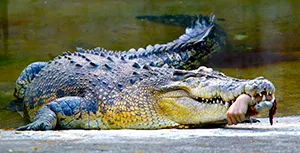Crocodiles: A Perfectly Designed Predator
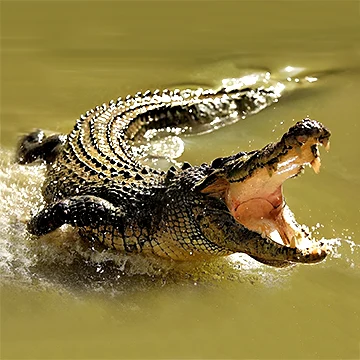
Contents
What is A Crocodile?
Crocodiles are formidable semi-aquatic ambush predators, renowned for their lightning-fast attacks and bone-crushing bites. They are among the deadliest predators on Earth and have existed for over 200 million years, that’s since the time of the dinosaurs.
Crocodiles possess tough, scaly skin, sharp claws, and powerful tails. Their short legs extend outward while their webbed rear feet improve swimming efficiency. Although they may seem slow and lumbering on land, crocodiles can gallop short distances at speeds of up to 18 kph (11 mph).
There are two primary types of crocodiles: the massive, highly aggressive Saltwater Crocodile and the smaller Freshwater Crocodile. The Saltwater Crocodile holds the title of the largest living reptile on Earth!
Crocodile Attacks: How Dangerous Are They?
Crocodiles are responsible for hundreds of fatal attacks on humans each year, making them far deadlier than sharks. Their bite force measures an astonishing 2,300 kg per square inch (psi)—compared to a human’s tiny 45 psi!
Crocodile's Keen Senses for the Kill
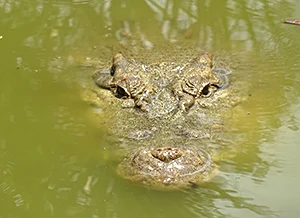
Photo: Crocodile's nose, eyes and ear-slits
• Eyes & Night Vision: Crocodiles have excellent vision, especially at night. A special reflective layer behind their retinas enhances their night vision, making them expert nocturnal hunters.
• Hearing & Smell: They can detect the slightest movements in water and have an acute sense of smell thanks to specialized receptors in their snouts.
• Nostrils & Ears: Positioned on top of their heads, allowing them to breathe and listen while staying submerged. Specialized valves in their ears and nostrils close to prevent water from entering when submerged.
• Transparent Eyelids: Crocodiles have a special nictitating membrane that acts like built-in goggles for underwater hunting.
About Crocodile Attacks
Crocodile's Tremendous Bite
A crocodile can exert a bite force of up to 2,300 kilograms per square inch (5,000 pounds per square inch)—far surpassing a human's modest 45 kg per square inch (100 psi). This tremendous force allows it to easily kill almost any animal it catches.
A crocodile's elongated snout is lined with 40-60 razor-sharp conical teeth designed for gripping and tearing apart prey. Unlike most animals, crocodiles continuously replace their teeth—up to 8,000 replacements over their lifetime. This adaptation ensures that their lethal bite never dulls.
Did You Know
While the muscles to close its jaws are extremely strong and can exert tremendous bite force, crocodiles have remarkably weak muscles for opening their mouths. In fact, an average human could hold a crocodile's jaws shut with just their bare hands.
How Crocodiles Walk, Run
How Crocodiles move
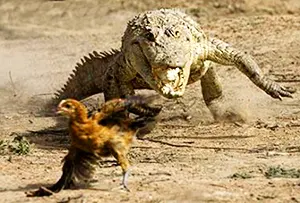
On land crocodiles appear slow and clumsy, often belly-crawling from place to place. However, crocodiles can trot, gallop, and bound at speeds of up to 18kph (11mph) for short distances. Follow this link for a detailed explanation.
How Do Crocodiles Swim
Crocodile Swimming
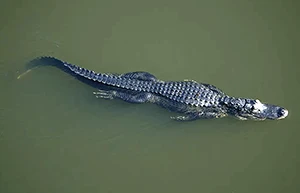
Crocodiles are excellent swimmers, and adjust their swimming technique depending on their speed. When moving slowly on the water's surface, they use their front and back legs to paddle, steer, and stabilize themselves. However, when they need to move quickly, they tuck their legs in close to their body and whips their tail from side to side in an ‘S' shaped pattern to propel themselves at speeds of up to 32kph (20mph). Additionally, their tail can be used as a weapon to slash and disable prey or knock it into the water.
Also a crocodile can remain submerged for up to an hour. It does this by closing its nostrils and a large fleshy flap of skin at the back of its throat to prevent water from entering its lungs and stomach when it opens its mouth underwater. It also reduces its heartbeat to just 3-4 beats per minute, thereby reducing its metabolic rate and oxygen requirements.
Crocodile Habitat & Distribution
Where Do Crocodiles Live?
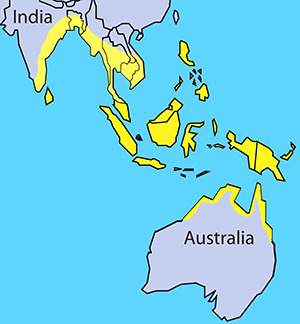
Photo: Crocodile habitat map
Crocodiles live in warm tropical and subtropical regions of Africa, Asia, the Americas, and Australia. They thrive in rivers, estuaries, lakes, swamps, and even coastal waters. They do not live at elevations higher than 250m above sea level.
Territorial & Migratory Behaviour
Crocodiles are territorial animals. Dominant males will usually claim prime hunting grounds, while younger or weaker crocodiles are forced into less favourable areas. Some species, particularly Saltwater Crocodiles, can venture into the open ocean and travel hundreds of kilometres!
Crocodile Hunting & Diet
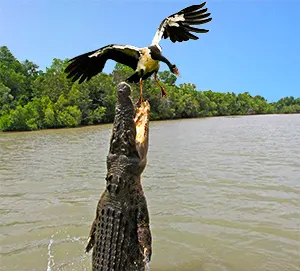
Photo: Crocodile catching a flying bird
What Do Crocodiles Eat?
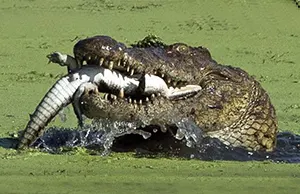
Photo: Crocodile eating another crocodile
Crocodiles are opportunistic apex predators and will eat almost any animal they can catch. These include fish, turtles, crustaceans, insects, frogs, lizards, birds (sometimes snatched out of the air), and other animals, large and small. The size of the prey a crocodile will attack is only limited by the crocodile's size and appetite. They will even attack and eat humans. Crocodiles are also cannibalistic and will eat each other. Recent research has found evidence of crocodiles eating fruit such as wild grapes, elderberries and citrus fruit directly from trees. A crocodile can eat up to half its body weight in a single meal.
Hunting Techniques & The Deadly "Death Roll"
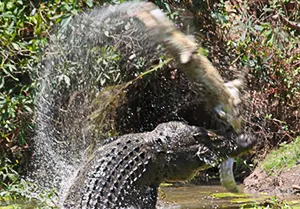
Photo: Crocodile thrashing its prey to kill it
Crocodiles use the element of surprise to ambush unsuspecting prey with lightning-fast attacks. Grasping their prey with their powerful mouths, they may execute an infamous Death Roll, twisting violently to tear their prey apart.
Crocodile Can't Chew
Crocodiles can't chew. Instead, they swallow their prey whole or rip it into chunks small enough to gulp down. Additionally, the crocodile has a fixed tongue that cannot be used to move objects around in its mouth. As a result, the crocodile can only gulp its food down.
Crocodiles Can Live for years without Eating!
Crocodiles can survive for months or even over a year without food. This is because a crocodile's energy requirements are extremely low.
Crocodile Reproduction & Life Cycle
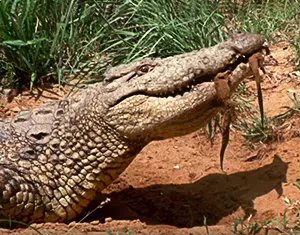
Photo: Crocodile carrying its babies in its mouth
During the mating season (November to April) males engage in fierce battles for the right to court females. Once mated, the female lays 40-60 eggs and covers them with 8-28 cm of nest material. Temperature inside the nest determines the hatchlings gender.
• Above 32°C, and the hatchlings will be male.
• Below 30°C, the hatchlings will be female.
When baby crocodiles are ready to hatch, they make a chirping sound from inside their eggs, which alerts their mother who carefully digs them out, and takes them to the water's edge and releases them. There she will protect them until they disperse over the following months.
Young hatchlings are about 28cm long and weigh an average of 71g. They are brightly patterned with dark and light bans and spots covering their bodies. They are exceptionally aggressive and will fend for themselves soon after birth, feeding mainly on small insects and other invertebrates.
Up to 75% of all crocodile eggs laid in a season do not hatch. This may be caused by flooding, overheating and under heating of the nest, poor gas exchange and desiccation of the eggs (eggs drying out). Only about 1% of hatchlings will survive to reach adulthood.
Male crocodiles reach sexual maturity at about 16 years of age and females at around 12. Crocodiles generally live for up to 80 years. A crocodile in captivity named "Cassius" lived to about 120 years!
Crocodile Predators & Threats
Who Eats Crocodiles?
Adult crocodiles have almost no natural predators, but young crocodiles fall prey to birds, big cats, monitor lizards, pythons, and even other crocodiles. In rare cases, hippos and large sharks can take down adult crocodiles.
Biggest Threat to Crocodiles: Humans
Human encroachment into areas inhabited by crocodiles is the biggest threat to their survival. Hunting, draining of swamps and mangroves and the property developments along the shorelines are displacing crocodiles from their natural environment and increasing the risk of crocodile-human conflicts. Introduced animals such as feral buffaloes and feral pigs are also responsible for destroying wetland habitats by increasing drainage, reducing vegetation, and trampling crocodile nesting sites. Many crocodiles, especially juveniles, are caught in fishing nets and drown.
Crocodile Conservation Status
Many species of crocodiles are vulnerable or endangered due to habitat destruction and hunting. However, conservation efforts have helped populations rebound in certain regions. Once on the brink of extinction, saltwater crocodiles are now thriving in Australia thanks to strict protection laws.
Crocodile Tears
The crocodile produces tears to clean its eyes. It has been observed shedding tears while feeding. Hence the phrase "crying crocodile tears" means displaying insincere emotions, such as crying fake tears of grief.
25 Crocodile Fun Facts!
- Crocodiles are cold-blooded reptiles that live in northern Australia and south-eastern Asia.
- The saltwater crocodile is the largest crocodile species. It can grow to 1200 kg and over 6m.
- The largest crocodile ever captured was 6.17m long and weighed 1,075kg!
- They can swim speeds up to 32 kph.
- Crocodiles can hold their breath underwater for about one hour.
- A crocodile's eyes, ears, and nostrils are at the highest points on its head so it can be active with its body underwater.
- Crocodiles eat almost any living thing and can go without food for long periods.
- They have a tremendous bite force when closing their mouths.
- But if you were brave enough to try, you could hold a crocodile's mouth shut using your bare hands.
- That's because they have very weak muscles to open their mouths.
- A crocodile's eating habits are best described as a ‘chomp and gulp'.
- They swallow their prey whole or tear it to pieces and swallow the pieces.
- Crocodiles cannot eat underwater, or they will drown.
- They swallow small stones to help it grind up food in their stomachs.
- Crocodiles do "cry crocodile tears" while eating.
- Crocodiles don't sweat. They use "mouth gaping", which is a lot like panting, to control their body temperature.
- Also, a crocodile's teeth protrude over their cheeks.
- The temperature of the nest determines the sex of the babies. Above 32°C for male. And below 30°C for female.
- A crocodile mother carries her babies in her mouth when moving them.
- Crocodiles have excellent homing instincts and will find their way back to their original location.
- Crocodiles are classified as reptiles, but are more closely related to dinosaurs and birds.
- They can live for up to 100 years.
- A crocodile has a V-shaped jaw, an alligator U-shaped one.
- Crocodiles are 10-20% larger than alligators and are far more dangerous.
- A group of crocodiles on land are called a 'a bask of crocodiles'. In water, they are called 'a float of crocodiles'.
Learn More About Australia's Incredibly Quirky Animals
All Rights Reserved. (Last Updated: Mar 30, 2025)
